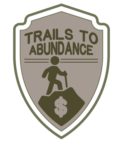Getting out of debt and in debt. Debt can be a useful tool or a noose around your neck depending on how you use it. Good debt is generally something like your home mortgage or a mortgage on a profitable investment property. Getting into debt on a home is a wonderful and often wise long term decision. If the asset you purchase with debt is appreciating you can generally consider that good debt. Likewise, if you own a business and use debt to increase your income by buying more inventory, equipment or vehicles that may also be a wise decision.
Where people run into problems is with bad debt on short term consumables like food, clothing, dinners out, and stuff they don’t need. Think about the idea of buying a nice dinner and then paying it off with the rest of their credit card balances over several months or years at 21.9% interest rates. Another common trap is making a small down payment on a new car. Taking a loan for more than 36-48 months, trading that car in just a couple years. Then buying another car and working yourself into a situation where you owe more on your car than it is worth. This is called a negative equity situation or being upside down. Cars depreciate very quickly, and car dealers want to sell cars. Please be careful and avoid these situations.
Getting out of debt by avoiding in the first place.
Of course it is obvious that it is easier to get into debt than to get out. Until you free up some cash flow for savings, build an emergency fund, get your income rising and built up some investments you are going to have to watch your spending. You must learn to tell yourself, your partner and often your kids, NO. You can say NO to new clothes all the time, meals out, the nicer car, expensive vacations, and many other indulgences. When you look back having said No and sitting in a much more comfortable financial situation you will be glad you said NO to a few extras. You will learn on these pages that what you do early on can make all the difference later on.
Watch where you are going
As a general rule if you can’t pay all your credit card charges off each month you are heading toward getting into deep debt. You have to trim back.
If you reach a point where your monthly loan payments other than housing are more 8-10% of your gross monthly income you are stretching your budget very thin. Example you earn $5,000 per month before taxes $4-500 per month is your cap on debt payments. This includes your credit cards, car payments, student loan payments and any other debt payments. Your exact situation is probably different and if you are still reading this the assumption is you have more work to do. Keep reading.
Slash Your Spending – Needs and Wants

If you have student debt, one or more car loans and are losing the fight with your credit cards it is time for drastic action. Unfortunately, debt can become a downward spiral. It is a very bad trail to be on and will not result in abundance. Having reviewed thousands of people’s personal financial statements as a lender, you can easily spot those who are not on a good financial path. Very little savings, large car payments, student loan debt and looking to borrow more than they should. The trajectories of good and bad debt and savings patterns go in one direction. Up or down.
If you are in or headed in a bad direction, move to action! Progress will not be immediate, but you can turn almost anything around.
“The man who never has money enough to pay his debts has too much of something else.”
-James Lendall Basford
Slash your expenses add some income – If your situation is dire then do it quickly.
- Cable bill, just turn it off for a while or keep just keep internet and use other free or low cost entertainment options.
- Stop all discretionary spending – no new gadgets, clothes, or meals out.
- Brown bag it to work – skip coffee from stores – bottled water for many people is an unneeded expense.
- Turn down your heat and air a little – turn off lights – use less water.
- Cell phones are a big expense for people. Call your provider and check for better options. Moving down a level of service can save $25-100 per month.
- Pick-up an extra job for a while – See our article on Extra Income and Side Hustles.
- Drive less – Consolidate trips.
You can also consider moving away from credit cards and transition over to using a debit card. By doing this and only buying necessities it forces you to pay for things as you need them. In the meantime, you can work your credit card balance(s) down and then attack your loans.
Lets keep Slashing Away That Debt
- Refinance your student loans
- Consolidate debt with a Peer-to-peer lender.
- Boost your income – Work toward a promotion, better job or a good side hustle.
- Sell stuff – People often have hundreds if not thousands of dollars tied up in stuff they don’t need.
- Trim your outflow to children – Be generous but fair with kids.
At the same time as you are slashing your spending and looking for some new income, start saving. Force yourself to at least start a very small savings program of just $10.00 per month if that is all you can do right now. If you are not yet contributing start by contributing just 1% of your income to your 401K or 403B plan. You must save and the first step is setting up some automatic savings. See our article on How to Start Saving and Tracking Your Net Worth. Trim the spending and start saving today!

